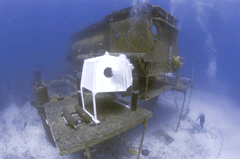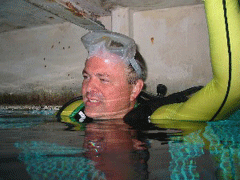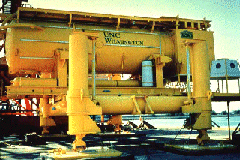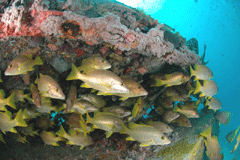Undersea Classroom
Air Date: Week of November 16, 2007

Aquarius with the gazebo - the location where the divers can fill their air tanks when they're running low.(Photo: DJ Roller/Liquid Pictures)
A group of marine biologists are living and working deep beneath the surface of the sea in a research station off the coast of Florida. They're studying the health of nearby coral reefs and broadcasting their findings live to students all over the world. Dr. Mark Patterson is the chief scientist of the mission. He joins us from 20,000 millimeters under the sea.
Transcript
CURWOOD: Studying the effects that a changing climate has on our oceans is exactly what a team of scientists is doing off the coast of Florida. They're actually living beneath the surface of the sea in a laboratory called Aquarius. This team of Aquanauts—that’s right, Aquanauts—is studying coral reefs round the clock for five days, and broadcasting live ‘underwater classroom’ sessions to students across the world via the Web.
[DIVER TAKES A BREATH AND ANNOUNCES ‘I’M BACK OUT HERE ON CONCH REEF AND I WANT TO SHOW YOU SOMETHING THAT MAKES AQUARIUS SPECIAL IS THAT WE CAN DO EXPERIMENTS FROM THE SEA FLOOR’]
CURWOOD: Aquanaut Dr. Mark Patterson is the chief scientist for the Project SeaCAMEL mission. He’s on the line from Aquarius. Hello from those of us above the water, Mark.

Mark Patterson gets ready to head out for a dive.(Courtesy of the Living Oceans Foundation)
CURWOOD: Or it’s about 60 some odd feet, in other words.
PATTERSON: Yeah, the base is down at 60 feet and then the hatch that we—the moon pool that we enter and leave the habitat from is about 50 feet deep. And we can range as deep as 130 feet deep around the habitat.
CURWOOD: So, tell me what it’s like living down there and what’s the most difficult thing about living in something that’s what—maybe the size of a school bus?

Aquarius (Photo: UNCW/NURC)
CURWOOD: Wait a second—underwater weather?

Fish are at home, cozy-ing up to the bottom of Aquarius. (Photo: Annelise Hagan)
PATTERSON: Yeah, we see the ebb and flow and the tides and the currents. We get to see how the ocean changes in a way that you don’t appreciate unless you’re living here.
CURWOOD: How does living in Aquarius offer better research as opposed to doing daily dives?
PATTERSON: There’s two aspects. One is that we can dive a full workday and not have to worry about decompression illness when we go to the surface. So we can get done in ten days what might take us six months or more diving from the surface. The second advantage to doing science here is that we have power from the habitat and we’ve got computers inside the habitat so we can do more sophisticated types of experiments.

Aquarius with the gazebo - the location where the divers can fill their air tanks when they're running low. (Photo: DJ Roller/Liquid Pictures)
PATTERSON: Oh, it’s an ever-changing show at night so there have been some missions in Aquarius where they specifically look at aspects of the biology or the chemistry of the reef that change in the dark hours.
CURWOOD: Now, tell me about your helper there. In particular you have a robotic fish named ‘Fetch?’
PATTERSON: That’s right. Fetch is a free-swimming computer. It’s got no tether, so you program the robot on a mission and then send it off swimming and it surveys what’s going on in the water column over the reef and it can also survey the animals living right on the bottom.
CURWOOD: So what are your specific goals for research while you’re living in Aquarius?
PATTERSON: Well I’m a veteran user. This is my seventh time here. And in the past I’ve used Aquarius to do experiments on how motion in the ocean affects the physiology of the corals and their allies that live on the reef. So, I’ve set up specialized equipment to investigate how the speed of the water moving past the surface of the corals affects their respiration rate and since they’re half plants with symbiotic algae living inside them, corals also photosynthesize during the day so we’ve investigated photosynthesis.
This particular mission—Project SeaCAMEL—is a short mission, where we’re actually trying to do teaching at the university level from the bottom of the sea.
CURWOOD: Dr. Mark Patterson is the chief scientist for the project SeaCAMEL. CAMEL stands for Classroom Aquarius Marine Education Live, teaching students from 60 feet underneath the ocean. Thank you so much, Dr. Patterson.
PATTERSON: Oh, it’s my pleasure. Thank you.
CURWOOD: For a link to the Project SeaCAMEL website, where you can watch the archived undersea classroom broadcasts, go to our website: loe.org.
Links
Living Ocean's Foundation: Project SeaCAMEL (Classroom Aquarius Marine Education Live)
Living on Earth wants to hear from you!
Living on Earth
62 Calef Highway, Suite 212
Lee, NH 03861
Telephone: 617-287-4121
E-mail: comments@loe.org
Newsletter [Click here]
Donate to Living on Earth!
Living on Earth is an independent media program and relies entirely on contributions from listeners and institutions supporting public service. Please donate now to preserve an independent environmental voice.
NewsletterLiving on Earth offers a weekly delivery of the show's rundown to your mailbox. Sign up for our newsletter today!
 Sailors For The Sea: Be the change you want to sea.
Sailors For The Sea: Be the change you want to sea.
 The Grantham Foundation for the Protection of the Environment: Committed to protecting and improving the health of the global environment.
The Grantham Foundation for the Protection of the Environment: Committed to protecting and improving the health of the global environment.
 Contribute to Living on Earth and receive, as our gift to you, an archival print of one of Mark Seth Lender's extraordinary wildlife photographs. Follow the link to see Mark's current collection of photographs.
Contribute to Living on Earth and receive, as our gift to you, an archival print of one of Mark Seth Lender's extraordinary wildlife photographs. Follow the link to see Mark's current collection of photographs.
 Buy a signed copy of Mark Seth Lender's book Smeagull the Seagull & support Living on Earth
Buy a signed copy of Mark Seth Lender's book Smeagull the Seagull & support Living on Earth

